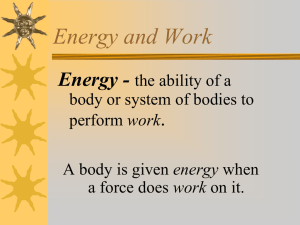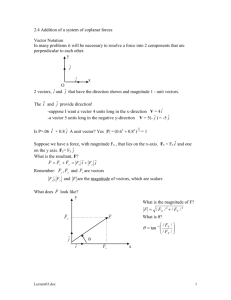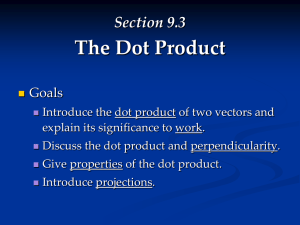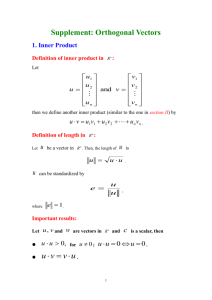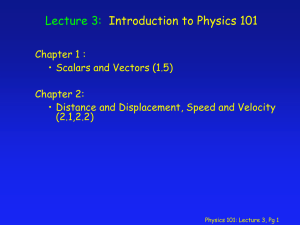Vectors and Vector Operations
advertisement
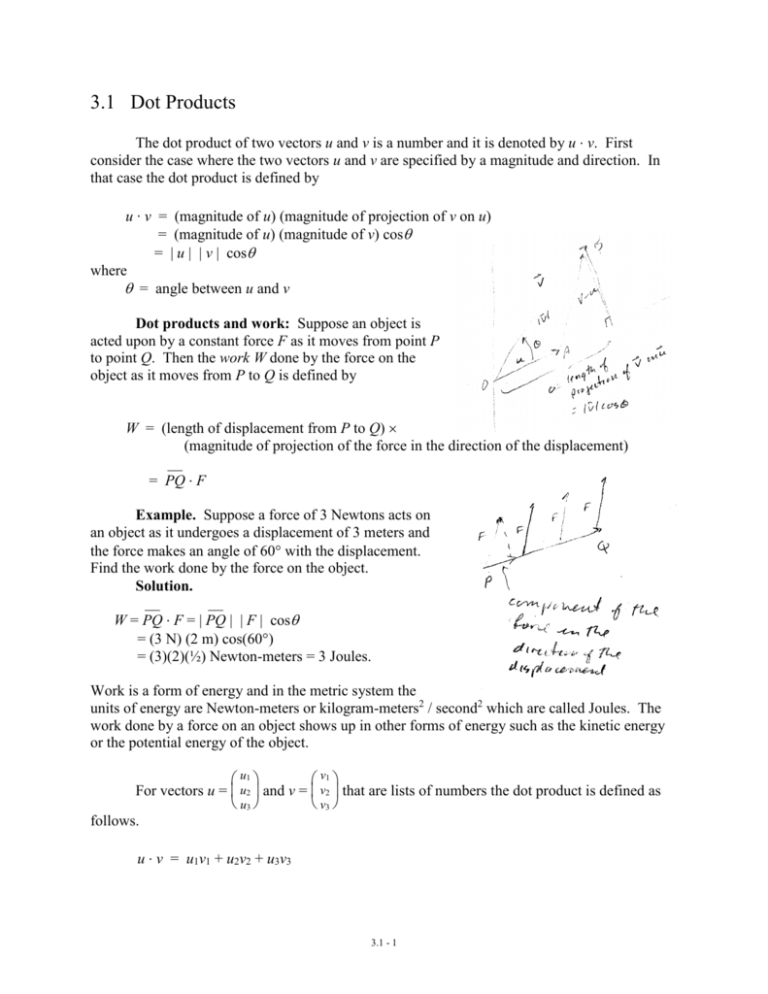
3.1 Dot Products The dot product of two vectors u and v is a number and it is denoted by u . v. First consider the case where the two vectors u and v are specified by a magnitude and direction. In that case the dot product is defined by u . v = (magnitude of u) (magnitude of projection of v on u) = (magnitude of u) (magnitude of v) cos = | u | | v | cos where = angle between u and v Dot products and work: Suppose an object is acted upon by a constant force F as it moves from point P to point Q. Then the work W done by the force on the object as it moves from P to Q is defined by W = (length of displacement from P to Q) (magnitude of projection of the force in the direction of the displacement) __ = PQ . F Example. Suppose a force of 3 Newtons acts on an object as it undergoes a displacement of 3 meters and the force makes an angle of 60 with the displacement. Find the work done by the force on the object. Solution. __ __ W = PQ . F = | PQ | | F | cos = (3 N) (2 m) cos(60) = (3)(2)(½) Newton-meters = 3 Joules. Work is a form of energy and in the metric system the units of energy are Newton-meters or kilogram-meters2 / second2 which are called Joules. The work done by a force on an object shows up in other forms of energy such as the kinetic energy or the potential energy of the object. u1 v1 For vectors u = u2 and v = v2 that are lists of numbers the dot product is defined as u3 v3 follows. u . v = u1v1 + u2v2 + u3v3 3.1 - 1 Proposition. Suppose u and v are vectors that are specified by a magnitude and direction and one introduces a coordinate system so that u and v are represented by lists of numbers, i.e. u1 v1 u = u2 and v = v2 . Then u . v = u1v1 + u2v2 + u3v3. u3 v3 Proof. Apply the law of cosines to the triangle whose sides are u and v. One obtains | v – u |2 = | u |2 + | v |2 – 2 | u | | v | cos (v1 – u1)2 + (v2 – u2)2 + (v3 – u3)2 = (u1)2 + (u2)2 + (u3)2 + (v1)2 + (v2)2 + (v3)2 – 2 u . v -2 (u1v1 + u2v2 + u3v3) = – 2 u . v u . v = u1v1 + u2v2 + u3v3 Finding the angle between two vectors. We can use the above formulas to find the angle between two vectors that are given in component form, i.e. = cos-1 | u | u.v |v| Example. Find the angle between u = 2i – 3j + k and v = i + 2j - k. 2 1 Solution. u = -3 and u = 2 , so 1 -1 = cos-1 | u | u.v |v| (2)(1) + (-3)(2) + (1)(-1) = cos-1 -5 = cos-1 2 2 2 2 2 2 2 + (-3) + 1 1 + 2 + (-1) 14 6 -1 = cos (-0.546) = 2.15 (radians) = 123.1 Orthogonal vectors. Two vectors u and v are orthogonal if they are perpendicular, i.e. if the angle between them is 90. This occurs precisely if cos = 0 or u . v = 0. Example. Let P be the set of vectors u = xi + yj + zk that are orthogonal to the vector v = - i + 2j + 2k. Note that P is a plane passing through the origin. Find the equation that points on this plane satisfy. Solution. Points on this plane satisfy u.v=0 (xi + yj + zk) . (- i + 2j + 2k) = 0 - x + 2y + 2z = 0 Example. Let P be the set of vectors u = xi + yj + zk that satisfy the equation 3x - 2y + z = 0. Describe P geometrically. 3.1 - 2 Solution. 3x - 2y + z = 0 (xi + yj + zk) . (3i - 2j + k) = 0 u.v=0 where v = 3i - 2j + k. This is the plane consisting of all vectors u that are orthogonal to v. Projection of one vector on another. Suppose we are given two vectors u and v and we want to find the projection of v on u. We start with the formula u . v = (magnitude of u) (magnitude of projection of v on u) = | u | (magnitude of projection of v on u) Solving for the magnitude of the projection v on u gives u.v magnitude of projection of v on u = | u | In order to get the projection of v on u we have to multiply a unit vector in the direction u of u by this. A unit vector in the direction of u is | u |. So Projection of v on u = (u . v) u | u |2 Example. Find the projection of v = 3i + 2j + 2k on u = 2i + 2j + k. (u . v) u (3*2 + 2*2 +2*1) (2i + 2j + k) = | u |2 22 + 22 + 12 12 (2i + 2j + k) 8 8 4 = 3i+3j+3k 9 Solution. Projection of v on u = = Algebraic properties of dot products. It is not hard to see that u.v = v.u (the dot product is symmetric) 2 . u u = |u| (cu) . v = c (u . v) if c is a number (the dot product is homogeneous) u . (v + w) = u . v + u . w (a distributive law) i.i = 1 j.j = 1 k.k = 1 i.j = 0 i.k = 0 j.k = 0 3.1 - 3



